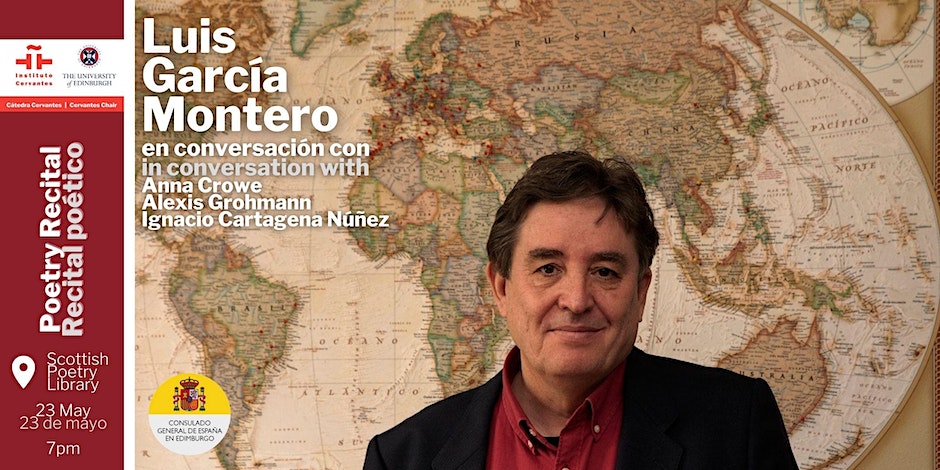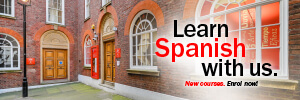La primera Cátedra Cervantes se inaugura el miércoles en la Universidad de Edimburgo
El director del Instituto Cervantes, Luis García Montero, viaja a Reino Unido donde este miércoles, 24 de mayo, inaugurará la Cátedra Cervantes en la Universidad de Edimburgo, una iniciativa dedicada a impulsar la enseñanza y promoción del español y de la cultura hispánica en Escocia. Dependiente del Instituto Cervantes de Mánchester, supone el establecimiento de la primera extensión de la institución en la capital escocesa. Alexis Grohmann, hispanista y catedrático de Literatura Española Contemporánea, ocupará la cátedra.

Para el desarrollo de su actividad, la Cátedra Cervantes contará con el respaldo del departamento de español Universidad de Edimburgo, con un siglo de historia; con la figura del Catedrático Cervantes, profesor de la propia universidad quien apoyará la labor del Instituto Cervantes; y con la cesión de los espacios necesarios para la realización de cursos de formación de profesores y programas culturales.
Al acto de inauguración asistirán, además de García Montero, el rector de la Universidad de Edimburgo, Peter Mathieson; la directora Académica del Instituto Cervantes, Carmen Pastor; el cónsul general de España en Edimburgo, Ignacio Cartagena, y el nuevo Catedrático Cervantes, Alexis Grohmann.
Esta iniciativa nace con el apoyo de las autoridades escocesas, como se puso de relieve en el encuentro que mantuvo García Montero (en una visita previa a la capital escocesa) con el vicepresidente del parlamento escocés, Liam McArthur; y en una posterior visita del ministro de Constitución, Asuntos Exteriores y Cultura del Gobierno de Escocia, Angus Robertson, a la sede central del Cervantes en Madrid.
La Universidad de Edimburgo, fundada en 1583, es una de las más grandes y prestigiosas del Reino Unido. La enseñanza del español en Escocia en los últimos años ha tenido un crecimiento sostenido, un hecho que puso de relieve el informe Language Trends, del British Council, que mostraba el afianzamiento del idioma español como la lengua extranjera más demandada por los estudiantes de secundaria en todo el Reino Unido.
Agenda de García Montero en Edimburgo
El programa en la ciudad escocesa arrancará este martes 23 de mayo con la celebración de un recital en la Biblioteca de la Poesía en el que participarán, junto a Luis García Montero, la poeta y traductora Anna Crowe y el catedrático Alexis Grohmann, además de cónsul General de España en Edimburgo, Ignacio Cartagena.
Al día siguiente, en el consulado, el director del Cervantes se reunirá con el profesor de Lingüística Hispánica y coordinador de los programas de enseñanza en línea del Departamento de Lenguas y Culturas Europeas de la Universidad de Edimburgo, Carlos Soler.
Ese mismo día, 24 de mayo se celebrará la inauguración de la Cátedra Cervantes en la Universidad de Edimburgo (a las 18:30 h —hora local de Escocia—), acto en el que intervendrán el rector de la Universidad de Edimburgo, Peter Mathieson, el director del Cervantes, Luis García Montero, el cónsul general de España, Ignacio Cartagena Nuñez y el Catedrático Cervantes Alexis Grohmann.
Catedrático de Literatura Española Contemporánea en la School of Literatures, Languages and Cultures, Grohmann es, además, director de la Cátedra Arturo Pérez-Reverte, en la Universidad de Murcia y académico correspondiente extranjero, de la Real Academia Española. Autor de un centenar de publicaciones, entre sus trabajos destaca la investigación acerca de los autores Javier Marías y Arturo Pérez-Reverte, sobre los que ha publicado sendos ensayos.
El español en Escocia
Con cinco millones de habitantes, Escocia es una de las cuatro regiones administrativas que integran el Reino Unido —junto con Inglaterra, Gales e Irlanda del Norte—. Su capital, Edimburgo, destaca por su gran oferta cultural y proyección internacional con numerosos festivales como el Festival Internacional del Teatro de Edimburgo y el Festival Internacional de las Artes de Edimburgo
En los últimos años la enseñanza del español ha crecido regularmente en el país pese al declive gradual de la enseñanza de lenguas extrajeras en la región. Asimismo, los informes del British Council Language Trends constatan que el español es una de las lenguas estratégicamente más importantes para el Reino Unido.
Actualmente se enseña español en casi la mitad de las escuelas de primaria y en dos tercios de los institutos de secundaria lo ofrecen como lengua tercera, sin embargo, existe una gran necesidad de programas de formación a profesores de español para atender a la demanda.
Próximo programa de actividades académicas y culturales
La Cátedra Cervantes plantea en el ámbito académico un programa de formación de profesores con el DADIC (Diploma de Acreditación Docente) que incluirá la observación de clases en la Universidad de Edimburgo para los profesores participantes, un curso sobre la legua de herencia o la oferta de cursos de español para profesores utilizando la plataforma AVE.
Entre las actividades culturales, participará en la Feria del Libro de Edimburgo, el Festival de Cine Español de Edimburgo, el Simposio internacional de poesía española en la Universidad de Saint Andrews, y la celebración de una mesa redonda sobre la figura de Javier Marías en Reino Unido.
The University of Edinburgh welcomes the first Cervantes Chair on Wednesday 23rd May
The director of the Instituto Cervantes, Luis García Montero, travels to the United Kingdom where on Wednesday he will inaugurate the Cervantes Chair at the University of Edinburgh, an initiative dedicated to the stimulation of the teaching and promotion of the Spanish language, and the dissemination of Hispanic culture in Scotland. Dependent on the Instituto Cervantes in Manchester, this event heralds the official establishment of the first extension of the institution in the Scottish capital. Alexis Grohmann, hispanist and Professor of Contemporary Spanish Literature, will occupy the Cervantes chair.

For the development of its activity, the Cervantes Chair will have the support of the Spanish Department at the University of Edinburgh, with its century of history. The figure of the Cervantes Professor, a professor from the university itself, will support the work of the Cervantes Institute. The activity of the extension will also be developed via the assignment of the necessary spaces for the realization of teacher training courses and cultural programmes.
The inauguration ceremony will be attended by the Principal of the University of Edinburgh, Peter Mathieson; the Academic Director of the Instituto Cervantes, Carmen Pastor; The Consul General of Spain in Edinburgh, Ignacio Cartagena, and the Cervantes Professor, Alexis Grohmann; as well as by Luis García Montero himself.
This initiative was developed with the support of the Scottish authorities, as highlighted in the meeting held by García Montero (on a previous visit to the Scottish capital,) with the Deputy President of the Scottish Parliament, Liam McArthur; and in a subsequent visit, with the Minister for Constitution, Foreign Affairs and Culture of the Scottish Government, Angus Robertson, at the Instituto Cervantes Headquarters in Madrid.
The University of Edinburgh, founded in 1583, is one of the largest and most prestigious universities in the United Kingdom. The teaching of Spanish in Scotland has experienced a sustained increase in recent years, a fact highlighted by the British Council’s Language Trends report, which showed the consolidation of the Spanish language as the foreign language most demanded by secondary school students throughout the United Kingdom.
García Montero’s Agenda in Edinburgh
García Montero’s programme in the Scottish city will begin on Tuesday, 23rd May, with a Poetry Recital at the Scottish Poetry Library, in which the poet and translator Anna Crowe and Professor Alexis Grohmann, as well as Consul General of Spain in Edinburgh, Ignacio Cartagena will participate alongside Luis García Montero.
The following day, the Director of the Instituto Cervantes will meet, at the Consulate of Spain, with the lecturer of Hispanic Linguistics and coordinator of the online teaching programs of the Department of European Languages and Cultures of the University of Edinburgh, Carlos Soler.
On the same day, the 24th May, the inauguration of the Cervantes Chair will be held at the University of Edinburgh (at 6:30 p.m. local time in Scotland.) The Principal of the University of Edinburgh, Peter Mathieson, will address attendees, as well as the director of the Cervantes, Luis García Montero, the consul general of Spain, Ignacio Cartagena Nuñez and the Cervantes Professor Alexis Grohmann.
Professor of Contemporary Spanish Literature at the School of Literatures, Languages and Cultures, Grohmann is also director of the Arturo Pérez-Reverte Chair at the University of Murcia and foreign correspondent of the Royal Spanish Academy. Author of more than a hundred publications, his works include numerous books on the authors Javier Marías and Arturo Pérez-Reverte.
Spanish in Scotland
With a population of five million, Scotland is one of the four devolved regions constituting the United Kingdom, alongside England, Wales, and Northern Ireland. Its capital, Edinburgh, stands out for its great cultural offer and international projection with numerous festivals such as the Edinburgh International Theatre Festival and the Edinburgh International Festival of the Arts.
In recent years, the teaching of Spanish has grown steadily in the country despite the gradual decline in the teaching of foreign languages in the region. Likewise, the British Council report Language Trends confirm that Spanish is one of the most strategically important languages for the United Kingdom.
Spanish is currently taught in almost half of UK primary schools, with two thirds of secondary schools offering Spanish as a third language. This being said, there is a great need and demand for training programmes for Spanish teachers , in order to keep up with current trends.
Upcoming programme of academic and cultural activities
In the academic field, the Cervantes Chair proposes a teacher-training programme focussed on the DADIC (Diploma of Teaching Accreditation) that will include the observation of classes at the University of Edinburgh for participating teachers, a course on the Heritage Languages, as well as Spanish courses for teachers using the AVE platform.
In regards to cultural activities, the chair will participate in the Edinburgh Book Fair, the Edinburgh Spanish Film Festival, the International Symposium of Spanish Poetry at the University of Saint Andrews, and the celebration of a round table on the figure of Javier Marías in the United Kingdom.
Oxford celebra su “valiosa relación” con el Instituto Cervantes en el cincuentenario de la Facultad de Español
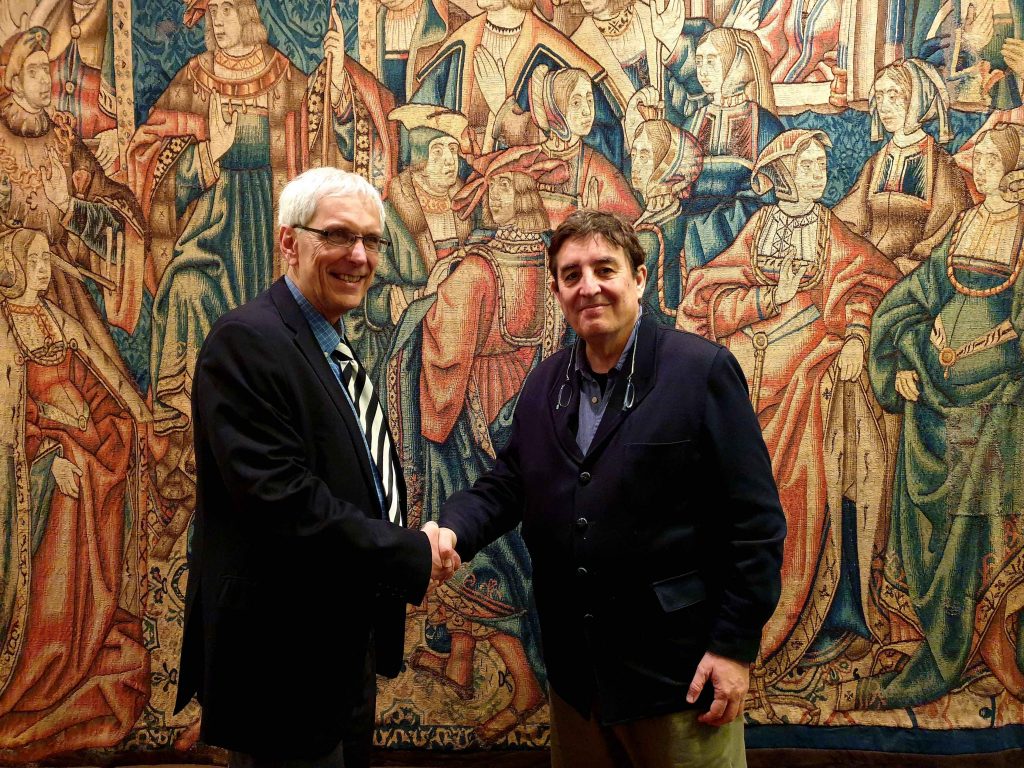
El director del Instituto Cervantes, Luis García Montero, acudió hoy a las celebraciones del 50 aniversario de la Subfacultad de Español y Portugués en la Universidad de Oxford y firmará mañana un memorando de entendimiento (MOU) con Magdalen College.
“La participación del Instituto Cervantes en esta conmemoración se debe a que nuestra relación es muy valiosa”, reconoció el profesor Jonathan Thacker, catedrático Alfonso XIII de estudios españoles en Oxford, quien explicó que si bien el español se enseña en esta universidad desde hace más de 100 años, es ahora cuando siente que “es una lengua realmente vibrante”.
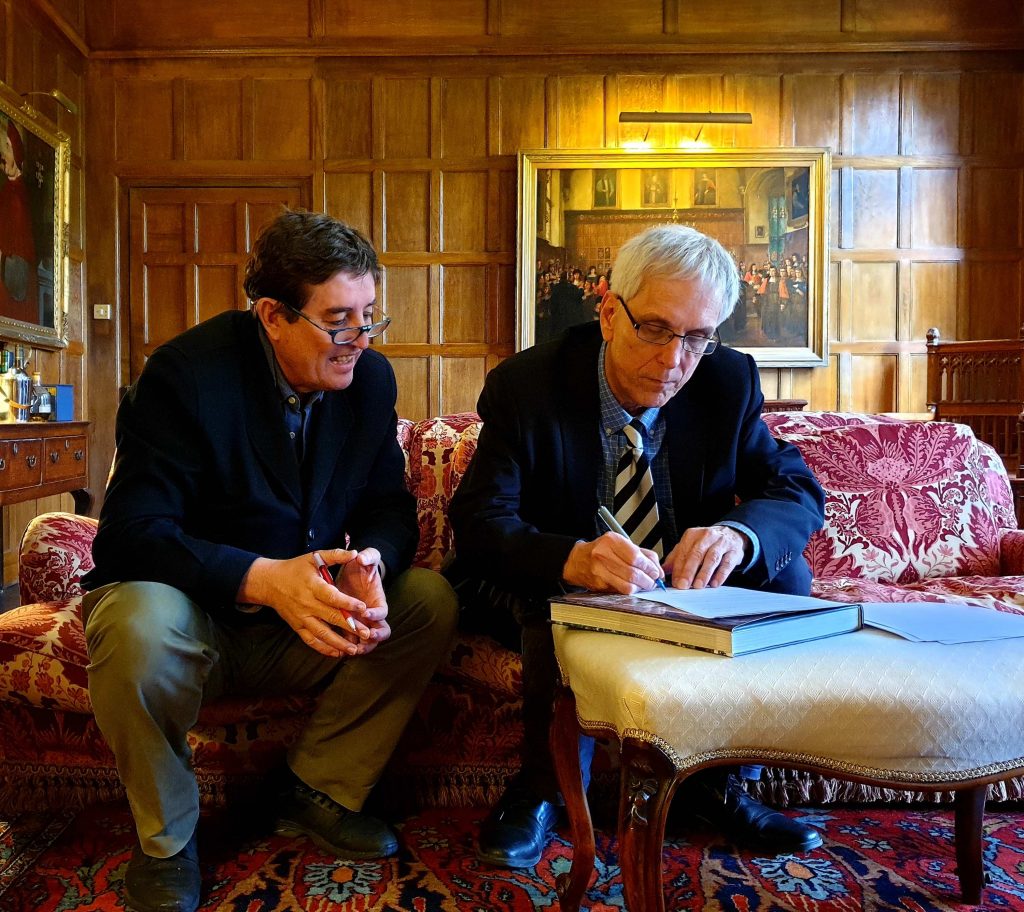
Experto en el Siglo de Oro español, el profesor Thacker afirmó que la asistencia de García Montero “no solo se debe a que es el director de una institución cultural muy importante, sino también un académico y un poeta, produciendo un tipo de literatura que enseñamos en Oxford. Queríamos que esta celebración fuese una combinación de contenido académico y un contenido más vivo”. En concreto, hubo lecturas de poesía del propio García Montero y la escritora portuguesa Ana Luísa Amaral.
Memorando de entendimiento con Magdalen College
“Este convenio es un reconocimiento de una trayectoria que lleva en marcha unos cuantos años y la consolidación de una colaboración futura que deseo que sea muy larga. Se trata de poner en negro sobre blanco lo que lleva tiempo desarrollándose, en especial en estos dos últimos años”, destacó el profesor de Literatura y Filología Medieval Española en la Universidad de Oxford, Juan Carlos Conde.
Para Conde, de lo que se trata con la firma de este memorando es de dar “carta de naturaleza y asegurarla para el futuro”. De hecho, tiene claro que la presencia de español en Oxford se ve fortalecida con dos iniciativas que se mencionan en el MOU: el Ciclo Madariaga y el Seminario de Estudios Medievales Ibéricos Magdalen (MIMSS, por sus siglas en inglés).
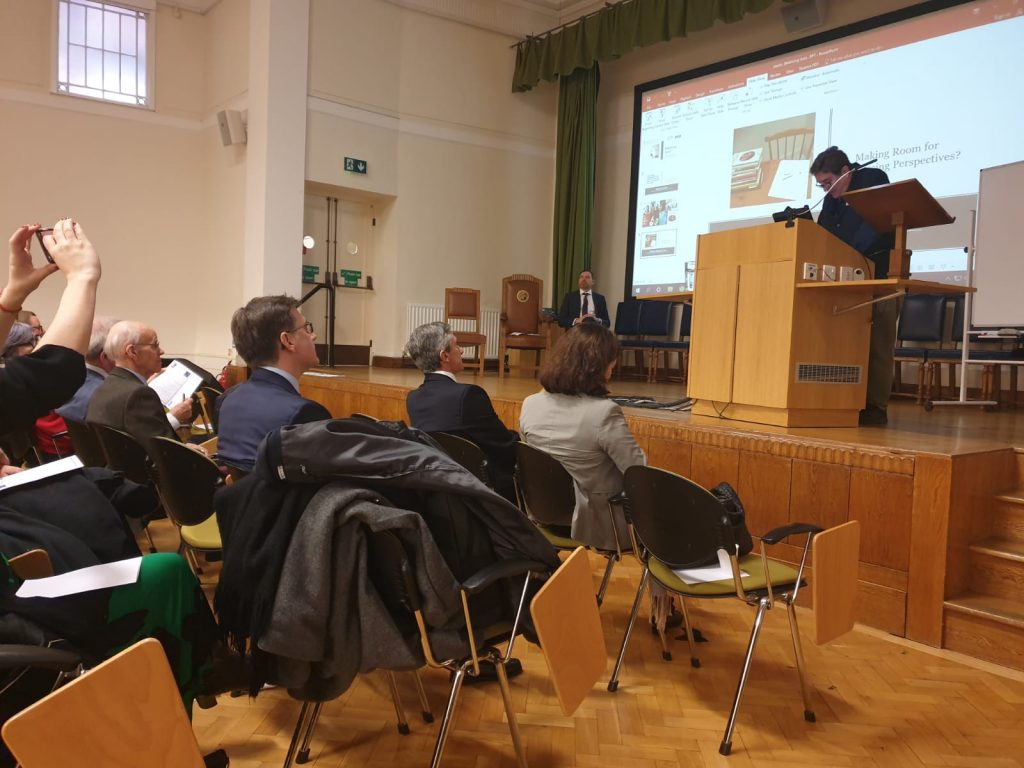
El Ciclo Madariaga surgió fruto de una iniciativa de un grupo de estudiantes de postgrado a finales de 2014. Entre los primeros invitados en 2015 hubo figuras de la talla de Miguel Ángel Moratinos o Javier Solana. Uno de los estudiantes detrás de la iniciativa, Diego Rubio, se dirigió a Conde para que Magdalen College le diese voz y visibilidad en Oxford y así fue como meses más tarde “les dio casa, techo y cobijo, así como una significativa contribución económica”. Y en el caso del ciclo MIMSS, se trata del seminario de estudios medievales más importante de Reino Unido en la actualidad.
“Quiero creer que estas actividades, en paralelo a la docencia y la formación, contribuirán a que la experiencia de los actuales y futuros estudiantes de Oxford sea más rica, proporcionándoles una serie de oportunidades que no tienen en otros lugares”, destacó Conde.
Estudiantes de español en Oxford
“Para estudiantes de grado que quieren estudiar aquí, tienen que haber cursado español previamente, hasta los exámenes de A-levels. Tenemos una media de entre 300 y 320 estudiantes que solicitan estudiar aquí y aceptamos entre 70 y 75, es decir, a uno de cada cuatro estudiantes. Creo que esto es una señal de la buena salud de la enseñanza de español en los colegios”, reconoció el profesor Thacker.

Hace 20 años, cuando el citado catedrático comenzó a trabajar en Oxford, había una media aproximadamente de 150 aplicantes para 40 puestos. “Hemos crecido bastante, pero la gran diferencia está marcada en que hay más aplicaciones por Lenguas Modernas, ya que cuando los estudiantes se postulan para estudiar aquí, tienen que escoger esa vía y luego especificar si quieren ruso, italiano, español o qué lengua”, puntualizó.
Mientras que el interés por el francés y el alemán está bajando, el español ha roto esa tendencia, y por el momento, todavía hay un buen nivel de aspirantes: “Espero que sea porque les gusta el nivel de nuestro curso, pero también porque hay mucha gente joven aquí interesada en la cultura hispánica y la historia española, y quieren viajar y les gusta viajar a países donde se habla español”.
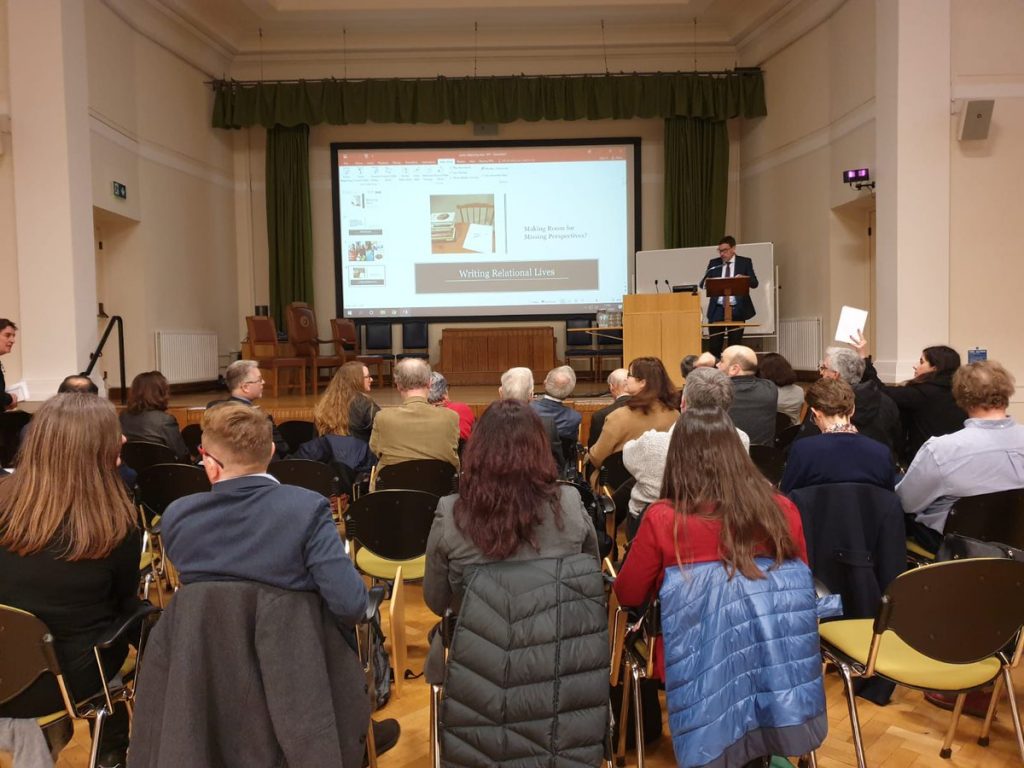
Futuro del español
A Thacker le gustaría seguir viendo al español creciendo en los próximos años y que la Subfacultad de Lenguas Medievales y Modernas en la Universidad de Oxford sea capaz de aceptar a todos los buenos solicitantes de estudios de español, tanto de grado como de posgrado, pero siempre manteniendo el nivel actual de interacción interdisciplinario y con otras Subfacultades en Oxford que hay en la actualidad.
Oxford celebrates its «valuable relationship» with Instituto Cervantes in the 50th anniversary of the Spanish Faculty

The director of Instituto Cervantes, Luis García Montero, attended today the 50th anniversary celebrations of the Spanish and Portuguese Sub-Faculty at the University of Oxford. Tomorrow, he will sign a memorandum of understanding (MOU) with Magdalen College.
“The participation of Instituto Cervantes in this commemoration is due to the fact that our relationship is very valuable,” said Jonathan Thacker, Professor Alfonso XIII of Spanish studies at Oxford, who explained that although Spanish has been taught at this university for more 100 years, only now does he feel that «it is a really vibrant language».

Expert in the Spanish Golden Age, Professor Thacker said that García Montero’s assistance “is not only because he is the director of a very important cultural institution, but also an academic and a poet, producing a type of literature that we teach in Oxford. We wanted this celebration to be a combination of academic content and more vivid content.” Alongside the celebration, there were poetry readings by García Montero himself and Portuguese writer Ana Luísa Amaral to enliven and complement the anniversary.
Memorandum of Understanding with Magdalen College
“This agreement is a recognition of a trajectory that has been underway for a few years and the consolidation of a future collaboration that I wish to be very long. It is about putting in black and white what has been developing for a long time, especially in these last two years,” said the professor of Spanish Medieval Literature and Philology at the University of Oxford, Juan Carlos Conde.
For Conde, the signing of this memorandum is to give, «a naturalisation certificate and secure it for the future.” In fact, it is clear that the presence of Spanish in Oxford is strengthened with two initiatives mentioned in the MOU: the Madariaga Series and the Magdalen Iberian Medieval Studies Seminar (MIMSS).

The Madariaga Series is the result of an initiative by a group of postgraduate students at the end of year 2014. Among the first guests in 2015 were figures such as Miguel Ángel Moratinos and Javier Solana. One of the students behind the initiative, Diego Rubio, approached Conde to ask whether Magdalen College could give the series voice and visibility in Oxford. A few months later, they successfully gave the Madariaga Series a “home, roof and shelter, as well as a significant economic contribution.» In the case of the MIMSS cycle, it is the most important medieval studies seminar in the United Kingdom today.
“I want to believe that these activities, in parallel to teaching and training, will contribute to the experience of current and future Oxford students, providing them with a series of opportunities they don’t have in other places,” said Conde.
Spanish students in Oxford
“For undergraduate students who want to study here, they must have previously studied Spanish up to A-levels exams. We have an average of between 300 and 320 students who request to study here and we accept between 70 and 75, that is, one in four students. I think this is a sign of the good health of teaching Spanish in schools,” said Professor Thacker.

Twenty years ago, when this professor began working at Oxford, there was an average of approximately 150 applicants for 40 positions. «We have grown a lot, but the big difference is that there are more applications for Modern Languages, because when students apply to study here, they have to choose that route and then specify if they want Russian, Italian, Spanish or what language,» he pointed out.
While interest in French and German is going down, Spanish has broken that trend, and at the moment, there is still a good level of applicants: “I hope it is because they like the level of our course, but also because there are a lot of young people here interested in Hispanic culture and Spanish history, and want to travel and like to travel to countries where Spanish is spoken. ”

Future of the Spanish language
Thacker would like to continue seeing Spanish growing in the coming years and that the Sub-Faculty of Medieval and Modern Languages at the University of Oxford is able to accept all good applicants for Spanish studies, both undergraduate and graduate. Alongside this growth is also an impetus on always maintaining the current level of interdisciplinary interaction and with other Sub-Faculties in Oxford that there are today.
Spain recognises the work of the great British historian, Paul Preston

The British historian and Hispanist Sir Paul Preston (Liverpool, 1946) will make an announcement in London on February 28th, that he has chosen to leave a copy of the first book he published in the Caja de las Letras, Instituto Cervantes’ headquarters in Madrid.
The Caja de las Letras is a vault of safe-deposit boxes in a former bank building that has been repurposed as a time capsule for Hispanic culture. Many Spanish artists and thinkers have been invited to leave an artifact of their choosing in the security boxes, along with the date the safe should be reopened.
In the case of Sir Paul Preston, he has chosen a book based on his thesis, The Destruction of Democracy in Spain (1978) which contains notes written by Hispanist Sir Raymond Carr. The first box ever used was Number 1,000 and was filled by writer Francisco Ayala in 2007. And for the first time in the history of the boxes, Preston’s donation is going to be done away from Madrid.
As Sir Paul Preston suffers from specific health problems that prevent him from travelling to Spain, his donated book will be taken to Madrid in a red briefcase guarded by the director of Instituto Cervantes, Luis García Montero.
«It is a great honor to join the Caja de las Letras, especially when it seems that there are very few writers who are not Spanish-speaking, and that has moved me,» said the British historian, who chose to open his box in five years time.
The text, a documented study that traces the origins of the Spanish Civil War, was started from the doctoral thesis that he presented at the University of Oxford about the monarchical conspiracies against the Spanish Republic. It is a copy much valued by Sir Paul Preston because of the annotations from his teacher, British historian and Hispanist Sir Raymond Carr (1919-2015).
“If you leave an object without further ado, for me it does not have much interest for those who open the Caja de las Letras in the future. That is why I thought that if someone interested in my work opens it, this has twice the interest, since it is my book and is annotated by Raymond Carr. In addition, this copy arrived to me in a very strange way: a friend found it in a second-hand bookshop and then he gave it to me,” explained Sir Paul Preston.
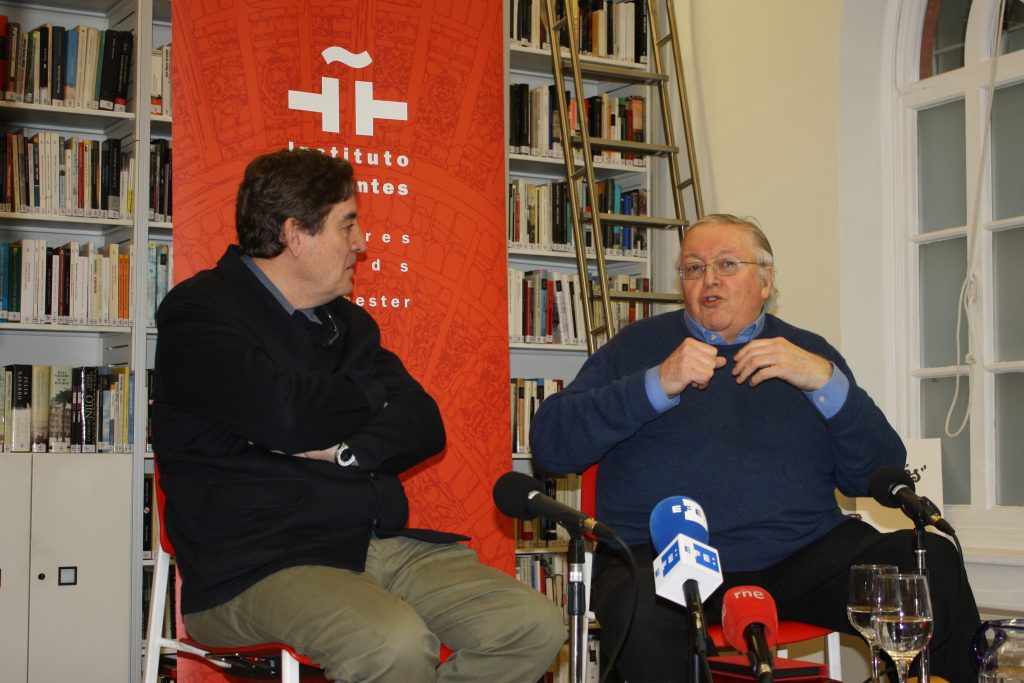
Disciple of Hugh Thomas
Sir Paul Preston’s childhood was spent in a working-class neighborhood of Liverpool, a city heavily punished by German bombing during World War II, as it was the port that received food and weapons shipments from the United States.
«I was born just after the War, but in my childhood the conversations of adults were very much about the bombings and the blitz, which came from the German expression blitzkrieg, quick war.» Very soon those stories became my favorite readings when I reached adolescence and I began to be interested in reading, above all, about the origins of World War II,” said the British historian.
Sir Paul Preston considered that he had «really incredible luck» for a working-class boy and from the North in being able to study History at Oxford University. «It was a small miracle and I was hoping, but among the subjects there were few which really impassioned me: almost everything was Constitutional History,» he added.
At the end of the race, and «wanting more», Sir Paul Preston again had «immense luck» when he was offered a scholarship to a postgraduate course on the period of Entreguerras (1918- 1939) at the University of Reading. “One of the subjects, the one that dealt with the Spanish Civil War, was given by Hugh Thomas. There I started teaching with him and everything fascinated me.”
From that moment, Sir Paul Preston began to «eat books» and read everything in English about the Spanish Civil War, realising that it was the perfect topic for his doctoral research: «It was a pandora box in which there was everything, fascism, communism, socialism, Freemasonry and great international figures (Stalin, Hitler, Trotsky…), etc.”
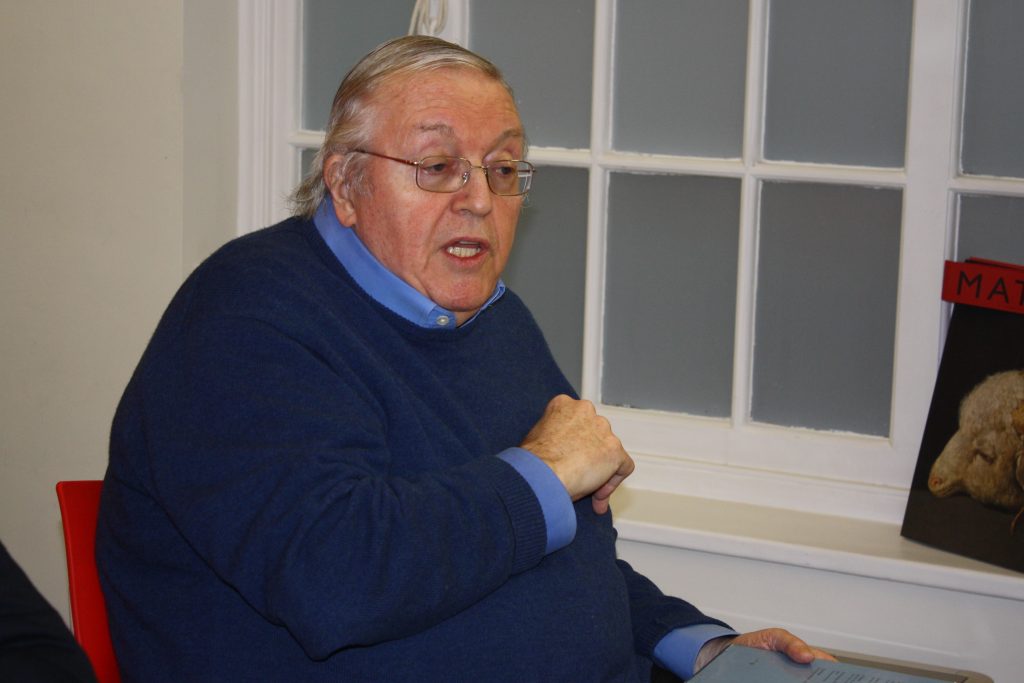
First trip to Spain
It was at that time that Sir Paul Preston decided that he «had to learn Spanish» and began to practice it with Colombian students in the cafeteria of the University. He traveled to Spain for the first time in the late 60s: “It was a great crush because Spain at that time had little to do with Spain today. I remember walking the streets of Madrid, the smells of food and the work of artisans.”
Sir Paul Preston acknowledged that he felt in love with Spain and was very excited with “the welcome that people gave me, I don’t know if it is like that now, but for someone who only babbled a couple of words in Spanish, people were very warm and they loved to see you and try to improve your Spanish, quite the opposite than in other countries.”
A life dedicated to the study of the History of Spain
Sir Paul Preston is a Doctor in History at the University of Oxford. He is a member of the British Academy and director of the Canada Blanch Centre of the London School of Economics, where he was Professor of International History for many years. Preston enjoys global fame as one of the greatest experts in the Spanish Civil War. He is also the author of reference biographies for Franco and Juan Carlos I.
Specialist in contemporary Spain, the historian has received the Commendation of the Order of Civil Merit and the Grand Cross of the Order of Isabel la Católica. Among his most outstanding works are Revolution and War in Spain 1931-1939 (1986); The Spanish Civil War (1987); Franco, leader of Spain (1994); Juan Carlos I (2003); The Spanish Holocaust (2011); the biography of Santiago Carrillo The red fox (2013), and his most recent and monumental work, A betrayed people: Spain from 1876 to the present day: Corruption, political incompetence and social division (2019).

First artifact in La Caja de las Letras made from a distance
The artifact left by Sir Paul Preston is the first one that is made from a distance in the history of Instituto Cervantes. The book donated by the great British historian will travel in a red briefcase guarded by the director of the Spanish institution, Luis García Montero.
With the delivery of his legacy, Sir Paul Preston joins another Hispanist historian Sir John Elliott, the first native non-Spanish speaker invited by Instituto Cervantes to the former vault of its headquarters in October 2017. This month, Irish Hispanist Ian Gibson joined him, choosing to leave as a legacy two books by Gerald Brenan.
The Caja de las Letras celebrated its first decade in 2018 as a time capsule that keeps legacies ceded by cultural personalities in Spanish. Writers, artists, musicians, scientists, filmmakers or actors have left locked-up personal objects that are witnesses and memories of their life trajectory in the former vault of the Instituto Cervantes’ headquarters.
Throughout these years, prominent protagonists of the culture of Spain and Latin America have deposited their legacies in one of the 1,800 safety boxes located in the building known as the Cariátide, in the centre of Madrid. Through their basements, all the writers awarded the Cervantes Prize in the last two decades have passed: Antonio Gamoneda, Juan Gelman, Ana María Matute, Juan Marsé, José Emilio Pacheco, José Manuel Caballero Bonald, Nicanor Parra, Elena Poniatowska, Juan Goytisolo, Fernando del Paso and Eduardo Mendoza.
Narrator and essayist Francisco Ayala, Cervantes Prize 1991, was the one who inaugurated the Caja de las Letras in February 2007 with a secret legacy in box number 2,000. Since then, other illustrious authors in addition to those mentioned, such as Carlos Edmundo de Ory, Pablo García Baena or Jorge Edwards, have left their mark in this peculiar enclave where customers formerly deposited jewels and treasure.
Although writers make up the majority of the boxes (almost twenty), many other expressions of culture are also represented: art (Antoni Tàpies), science (Margarita Salas), music (Cristóbal Halffter, Luis de Pablo), dance (Alicia Alonso, Víctor Ullate), cinema (Luis García Berlanga), theatre (Nuria Espert), interpretation (Manuel Alexandre), photography and edition (Mario Muchnik) or literary management (Carmen Balcells).
The boxes each have a specific opening date, chosen by each guest. There is only one exception: composer Luis de Pablo asked that his safe be opened when he dies (therefore, it is not known when) and that in the same act the unpublished score that he left saved there must be read. So far, three boxes have been reopened: those of the literary agent Carmen Balcells, actor Manuel Alexandre and molecular biologist Margarita Salas.
Among other objects, it is worth mentioning the typewriter of the recently deceased Nicanor Parra, who ceded his grandson in 2012, since the Chilean poet, who was then 97 years old, could not come to Spain to collect the Cervantes prize.
Legacies in memoriam
The Caja de las Letras also keeps four legacies in memoriam, that is, personalities already deceased. Colombian Nobel laureate Gabriel García Márquez retains a box with land from his home in Aracataca. Antonio Buero Vallejo, his pipe and one of the pens with which he wrote the plays. From writer Miguel Hernández, a first edition of his earliest poems, Perito en lunas (1933). And from Argentine singer Atahualpa Yupanqui, handwritten postcards sent to his wife during his trips.
Sir Paul Preston, protagonista del primer “legado a distancia” de la historia del Instituto Cervantes

El hispanista e historiador británico Sir Paul Preston (Liverpool, 1946) anunció hoy en Londres que depositará en la Caja de las Letras del Instituto Cervantes en Madrid, a modo de legado, un ejemplar del primer libro que publicó, basado en su tesis, La destrucción de la democracia en España (1978), anotado por el también hispanista Sir Raymond Carr.
El legado de Sir Paul Preston es el primero que se hace a distancia en la historia del Instituto Cervantes. El historiador británico padece problemas puntuales de salud que le impiden desplazarse a España, por lo que el libro donado viajará en un maletín rojo custodiado por el director de la institución española, Luis García Montero.
“Es un gran honor unirme a la Caja de las Letras, máxime cuando parece que hay poquísimos escritores que no son de lengua española, y eso me ha conmovido”, destacó el historiador británico, quien eligió que se abra su caja en cinco años, pensando en que sea una fecha cercana.
El texto, un documentado estudio que rastrea los orígenes de la Guerra Civil española, nació de la tesis doctoral que presentó en la Universidad de Oxford sobre las conspiraciones monárquicas en contra de la República española, y es un ejemplar muy apreciado por el hispanista, ya que tiene anotaciones de su maestro de Sir Paul Preston, el también historiador e hispanista británico Sir Raymond Carr (1919- 2015).
“Si dejas un objeto sin más, para mí no tiene mucho interés para quienes abran la Caja de las Letras en el futuro. Por eso pensé que si la abre alguien interesado en mi trabajo, esto tiene el doble de interés, ya que es mi libro y está anotado por Raymond Carr. Además, a mí me llegó este ejemplar de una forma muy estrafalaria: una amiga lo encontró en una librería de segunda mano y luego me lo regaló”, explicó Sir Paul Preston.

Discípulo de Hugh Thomas
La infancia de Sir Paul Preston transcurrió en un barrio obrero de Liverpool, una ciudad muy castigada por los bombardeos alemanes durante la Segunda Guerra Mundial, ya que era el puerto que recibía los envíos de comida y armamento desde Estados Unidos.
“Yo nací justo después de la Guerra, pero en mi infancia las conversaciones de los adultos versaban mucho sobre los bombardeos y el blitz, que venía de la expresión alemana blitzkrieg, ‘guerra rápida’. Muy pronto esas historias se convirtieron en mis lecturas favoritas cuando llegué a la adolescencia y comenzó a interesarme leer, ante todo, sobre los orígenes de la Segunda Guerra Mundial”, comentó el historiador británico.
Sir Paul Preston consideró que tuvo “una suerte realmente increíble” para un chico de clase de obrera y del norte, de Liverpool, al poder ir a la Universidad de Oxford a estudiar Historia. “Fue un pequeño milagro e iba con muchas esperanzas, pero entre las asignaturas había pocas que me apasionaran de verdad: casi todo era Historia constitucional”, añadió. Al terminar la carrera, y “con ganas de más”, el profesor Preston volvió a tener “una inmensa suerte”, ya que le ofrecieron una beca para ir a estudiar a la Universidad de Reading un posgrado sobre el período de Entreguerras (1918-1939). “Una de las asignaturas, la que versaba sobre Guerra Civil Española, la daba Hugh Thomas. Ahí empecé a dar clase con él y me fascinó todo”.
Desde ese momento, Sir Paul Preston empezó a “zampar libros” y leer todo lo que había en inglés sobre la Guerra Civil española, dándose cuenta de que era el tema perfecto para su investigación doctoral: “Era una caja de pandora en la que había de todo, fascismo, comunismo, socialismo, masonería y grandes figuras internacionales (Stalin, Hitler, Trotsky…), etc ”.
Primer viaje a España
Fue en ese momento en el que Sir Paul Preston decidió que “había que aprender español” y empezó a practicarlo con estudiantes colombianos en la cafetería de la Universidad. A España viajó por primera vez a finales de los 60: “Fue un gran flechazo porque la España de entonces poco tenía que ver con la España de hoy. Me acuerdo de andar por las calles de Madrid, de los olores de la comida y los trabajos de los artesanos”.
Sir Paul Preston reconoce que se enamoró de España y se emocionó mucho con “la bienvenida que me daba la gente, yo no sé si es así ahora, pero para alguien que solo balbuceaba un par de palabras en español, la gente tenía un tremendo calor y les encantaba verte e intentar mejorar tu español, todo lo contrario que en otros países”.

Una vida dedicada al estudio de la Historia de España
Sir Paul Preston es doctor en Historia por la Universidad de Oxford. Es miembro de la British Academy y director del Cañada Blanch Centre de la London School of Economics, en la que fue profesor de Historia internacional durante muchos años. Preston goza de fama global como uno de los mayores expertos en la Guerra Civil española. Es también autor de biografías de referencia de Franco y de Juan Carlos I.
Especialista en la España contemporánea, el historiador ha recibido la Encomienda de la Orden del Mérito Civil y la Gran Cruz de la Orden de Isabel la Católica. Entre sus obras más destacadas están Revolución y guerra en España 1931-1939 (1986); La Guerra Civil española (1987); Franco, caudillo de España (1994); Juan Carlos I (2003); El holocausto español (2011); la biografía de Santiago Carrillo El zorro rojo (2013), y su más reciente y monumental, Un pueblo traicionado: España de 1876 a nuestros días: Corrupción, incompetencia política y división social (2019).

Primer legado a distancia
El legado de Sir Paul Preston es el primero que se hace a distancia en la historia del Instituto Cervantes. El libro donado por el gran historiador inglés viajará en un maletín rojo custodiado por el director de la institución española, Luis García Montero.
Con la entrega de su legado, Sir Paul Preston se une a otro hispanista británico, Sir John Elliott, el primer hablante nativo no español invitado por el Instituto Cervantes a la Caja de las Letras de su sede en octubre de 2017. Este mes, se sumó el hispanista irlandés Ian Gibson, quien dejó como legado dos libros de Gerald Brenan.
La Caja de las Letras cumplió su su primera década en 2018 como cápsula del tiempo que guarda legados cedidos por personalidades de la cultura en español. Escritores, artistas, músicos, científicos, cineastas o actores han dejado custodiados bajo llave, en la antigua cámara acorazada de la sede del Instituto Cervantes, objetos personales que son testigo y recuerdo de su trayectoria vital.
A lo largo de estos años, destacados protagonistas de la cultura de España e Hispanoamérica han depositado sus legados en alguna de las 1.800 cajas de seguridad ubicadas en el conocido como edificio de las Cariátides, en el centro de Madrid. Por sus sótanos han pasado todos los escritores galardonados con el Premio Cervantes en los dos últimos lustros: Antonio Gamoneda, Juan Gelman, Ana María Matute, Juan Marsé, José Emilio Pacheco, José Manuel Caballero Bonald, Nicanor Parra, Elena Poniatowska, Juan Goytisolo, Fernando del Paso y Eduardo Mendoza.
El narrador y ensayista Francisco Ayala, premio Cervantes 1991, fue quien inauguró la Caja de las Letras en febrero de 2007 con un legado secreto en la caja número mil. Desde entonces, otros ilustres autores además de los mencionados, como Carlos Edmundo de Ory, Pablo García Baena o Jorge Edwards, han dejado su huella en este peculiar enclave donde los clientes de las sucesivas entidades bancarias que aquí se ubicaron décadas atrás atesoraban dinero, joyas u otros valiosos bienes.
Aunque los escritores son mayoría (casi una veintena), otras muchas expresiones de la cultura están asimismo representadas: el arte (Antoni Tàpies), la ciencia (Margarita Salas), la música (Cristóbal Halffter, Luis de Pablo), la danza (Alicia Alonso, Víctor Ullate), el cine (Luis García Berlanga), el teatro (Nuria Espert), la interpretación (Manuel Alexandre), la fotografía y la edición (Mario Muchnik) o la gestión literaria (Carmen Balcells).
Las cajas tienen fecha concreta de apertura, elegida por cada invitado. Solo hay una excepción: el compositor Luis de Pablo pidió que su caja de seguridad se abra cuando él muera (por tanto, no se sabe cuándo) y que en el mismo acto se interprete la partitura inédita que dejó guardada. Hasta el momento se han reabierto tres cajas: las de la agente literaria Carmen Balcells, el actor Manuel Alexandre y la bióloga molecular Margarita Salas.
Entre otros objetos, cabe citar la máquina de escribir del recientemente fallecido Nicanor Parra, que cedió en 2012 su nieto, ya que el poeta chileno, que contaba entonces con 97 años, no pudo venir a España a recoger el premio Cervantes.
Legados in memoriam
La Caja de las Letras también guarda cuatro legados in memoriam, es decir, de personalidades ya fallecidas con anterioridad. Del Nobel colombiano Gabriel García Márquez conserva una arqueta con tierra de su casa natal en Aracataca. De Antonio Buero Vallejo, su pipa y uno de los bolígrafos con los que escribía las obras dramáticas. De Miguel Hernández, una primera edición de su poemario más temprano, Perito en lunas (1933). Y del cantor argentino Atahualpa Yupanqui (el legado más reciente, del pasado 19 de enero), tarjetas postales escritas a mano y enviadas durante sus viajes a su esposa.
